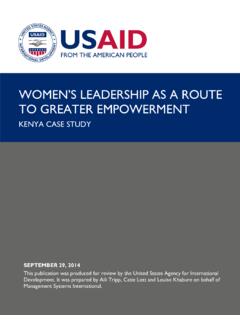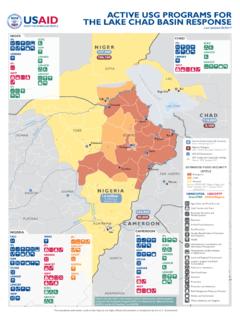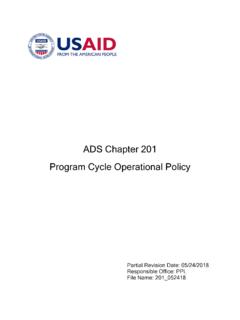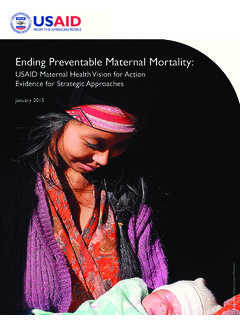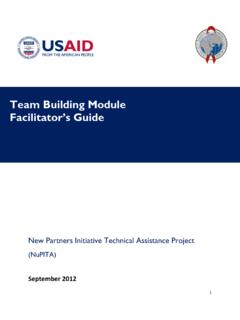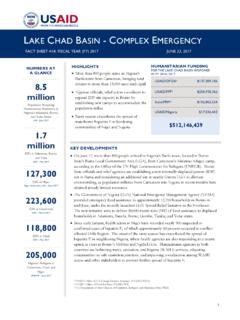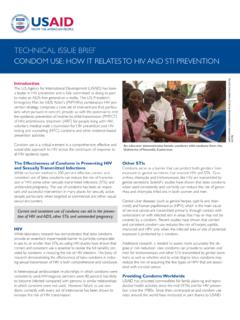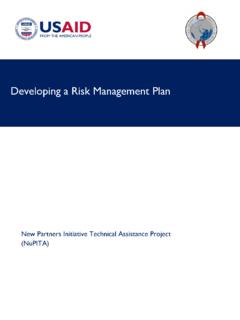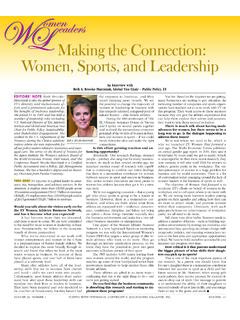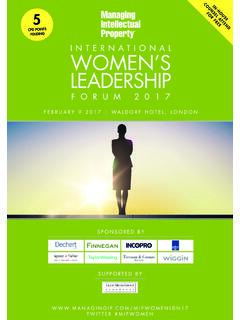Transcription of WOMEN’S LEADERSHIP AS A ROUTE TO GREATER …
1 women S LEADERSHIP AS A ROUTE TO GREATER empowerment DESKTOP STUDY OCTOBER 30, 2014 This publication was produced for review by the United States Agency for International Development. It was prepared by Mona Lena Krook, Darcy Ashman, Layla Moughari and Milad Pournik of Management Systems International. women S LEADERSHIP AS A ROUTE TO GREATER empowerment DESKTOP STUDY Management Systems International Corporate Offices 200 12th Street South Arlington, VA 22202, USA Tel: + 1 703 979 7100 / Fax: +1 703 979 7101 Contracted under IQC No: AID-OAA-I-10-00002, Task Order No. AID-OAA-TO-13-00046 USAID Contracting Officer s Representative: Julie Denham, DRG Center DISCLAIMER The author s views expressed in this publication do not necessarily reflect the views of the United States Agency for International Development or the United States Government.
2 women S LEADERSHIP AS A ROUTE TO GREATER empowerment i CONTENTS ACRONYMS .. II EXECUTIVE SUMMARY .. 1 KEY FINDINGS OF THE DESKTOP STUDY .. 1 RECOMMENDATIONS FOR FUTURE PROGRAMMING .. 3 I. INTRODUCTION .. 5 RESEARCH BACKGROUND .. 5 DEFINITION OF women S LEADERSHIP AND empowerment .. 7 II. METHODOLOGY .. 9 PROGRAM SELECTION .. 9 DATA COLLECTION AND ANALYSIS .. 9 III. KEY FINDINGS: PROMOTING women S LEADERSHIP AND POLITICAL empowerment .. 10 EXTENT OF USAID PROGRAMS .. 10 OVERVIEW OF PROGRAMMING AND NOTABLE PROGRAM ACTIVITIES .. 14 PROGRAM RESULTS AND PERFORMANCE .. 22 IV. RECOMMENDATIONS FOR FUTURE PROGRAMMING .. 32 KEY women S LEADERSHIP AND POLITICAL empowerment ACTIVITIES .. 32 PROGRAM PLANNING AND MANAGEMENT 34 REFERENCES .. 37 ANNEX 1. KEY QUESTIONS FOR THE DESKTOP STUDY .. 38 ANNEX 2. PROGRAM SUMMARY TABLE FOR DESKTOP STUDY.
3 40 ANNEX 3. SUMMARY OF TRANSITION PHASE ACTIVITIES .. 46 ANNEX 4. SUMMARY OF PRE-ELECTION PERIOD ACTIVITIES .. 48 ANNEX 5. SUMMARY OF ELECTION PERIOD 52 ANNEX 6. SUMMARY OF POST-ELECTION AND GOVERNANCE PERIOD ACTIVITIES .. 56 ANNEX 7. PROMISING OUTCOME INDICATORS .. 59 ANNEX 8. PROGRAM SUMMARIES .. 60 AFRICA .. 61 ASIA .. 78 EUROPE AND EURASIA .. 90 LATIN AMERICA AND THE CARIBBEAN .. 101 MIDDLE EAST .. 107 GLOBAL .. 113 women S LEADERSHIP AS A ROUTE TO GREATER empowerment ii ACRONYMS CEPPS Consortium for Elections and Political Process Strengthening DRG Center of Excellence on Democracy, Human Rights and Governance (USAID) EPT Elections and Political Transitions GII Gender Inequality Index ( UNDP) IDEA International Institute for Democracy and Electoral Assistance IPU International Parliamentary Union MENA Middle East and North Africa MP Member of Parliament NGO Non-Governmental Organization PMP Performance Monitoring Plan PR Proportional Representation UNDP United Nations Development Program USAID United States Agency for International Development WAG women s Action Group women S LEADERSHIP AS A ROUTE TO GREATER empowerment 1 EXECUTIVE SUMMARY The women s LEADERSHIP as a ROUTE to GREATER empowerment project seeks to map and assess selected USAID programs dedicated to enhancing women s LEADERSHIP and political empowerment .
4 This desktop study covers 56 programs identified by the Elections and Political Transitions (EPT) team of the Center of Excellence on Democracy, Rights and Governance (DRG), carried out in more than 50 countries between 2008 and 2013. The report provides an overview of program approaches and results globally; it is supplemented by five country case studies (Cambodia, Georgia, Kenya, Mexico, and Jordan) which offer an in-depth assessment of the women s political empowerment context and the program results achieved in each country. Two other studies include collecting data for 20 countries on the extent of women s LEADERSHIP in elected and appointed government positions and mapping work on women s LEADERSHIP and political empowerment in other USAID offices and bureaus. A two-day workshop in Washington DC with other donors, academics and implementing partners is being convened to discuss and disseminate the results.
5 Key Findings of the Desktop Study USAID/DRG/EPT-supported programs reach women leaders in politics globally The selected USAID programs to promote women s LEADERSHIP and political empowerment reach 55 countries in five regions, with more than half of the programs concentrated in Africa and Asia. In most cases, women s political empowerment is a secondary objective of broader transition and democratic strengthening programs. This made it difficult to track the overall funding for the women s empowerment program activities. However, information was available for the women -focused programs which showed that they were relatively small. Five of the ten were under $150,000 each. All of the women s political empowerment program activities operated over relatively short time frames, usually one to three years. No single definition of LEADERSHIP or empowerment ; a holistic approach The concept of women s LEADERSHIP and political empowerment is applied broadly across USAID programming, reflecting a relatively holistic approach to the political process.
6 It recognizes that women may play a variety of political roles voters, activists, candidates, elected officials and thus the need to empower women in all ways. Activities are organized in this report according to four moments of intervention transition, pre-election, election and post-election phases that vary in terms of content and focus, related to the different imperatives of each stage. Activities address key imperatives in transitions and during the electoral cycle USAID programs use common activities to address key imperatives during each of the four phases. Constitution development and women s LEADERSHIP in peace processes were a major focus during the transition stage. Pre-election programs emphasized work with political parties, training of prospective female candidates, civic and voter education, mobilization for gender quotas and establishing and strengthening women s networks.
7 During election time, the primary focus was on training actual female candidates, voter education, recruiting and training electoral observers and ensuring the implementation of gender quotas. Following elections, key activities included establishing and strengthening women s networks, capacity building for newly elected women , women S LEADERSHIP AS A ROUTE TO GREATER empowerment 2 creating and strengthening women s caucuses, policy dialogues on women and gender issues and pressuring elites to adopt gender quotas. Important results and strategies despite significant challenges for women Common achievements across USAID programming included the candidacy and election of women who had received training, development of action plans by political parties to incorporate women , initiation and strengthening of women s networks, electoral or legal reforms promoting gender equality, media coverage increasing awareness of women s political empowerment and increased voter participation rates in elections.
8 These achievements must be appreciated within the context of shared challenges in many countries including political conflict, which generates insecurity and uncertainty; uncooperative governments; lack of women s resources, stemming from illiteracy, lack of education, paid employment and political experience; cultures that are not responsive to or supportive of women s role in public life; and shortages of human and financial capital from local actors and donor agencies to ensure the success and long-term impact of program activities. Several strategies stand out for maximizing resources and transforming the status quo: new guidelines, policy statements and training to strengthen institutional gender capacity; reaching out to male allies in parties and parliaments; partnering with local organizations as implementers and local parties and female leaders as trainers and advocates to enhance the local relevance and sustainability of interventions; leveraging limited resources through the training of trainers and other network strategies to reach more women ; and engaging civil society organizations to reach GREATER numbers of female voters and candidates.
9 Illustrative quantifiable results Quantitative analysis yielded findings that may be considered illustrative, due to the variety of indicators and gaps in documentation. A count of results for the five most common activities shows the potential for cross-program reporting: with an average of 27% of the programs reporting, at least 3,372 women were trained as prospective or actual candidates; 359 women were elected from among those trained; and 1,244 women reported improvements in political skills or efficacy. At least 366 parties adopted policies to increase numbers and viability of female candidates, and at least 4,150,796 women received voter education. Several correlations, significant at 90 percent or higher, show interesting patterns in how USAID designs and manages these programs: USAID spends relatively more money on these programs in countries that are not yet Freedom House-rated electoral democracies; where parliaments have lower proportions of women , USAID devotes more activities to the aim of electing more women ; conversely, where parliaments have higher proportions, USAID s focus turns to elected women s LEADERSHIP , establishing women s caucuses and pursuing policy initiatives.
10 The highest-performing programs were in countries with higher percentages of women in parliament and higher income levels. Programs that focused on elections exclusively were less likely to perform well. The highest-performing programs were managed with fewer key indicators than others; three to five indicators associated with key activities are more manageable than six or more. women S LEADERSHIP AS A ROUTE TO GREATER empowerment 3 Recommendations for Future Programming Focus on key women s LEADERSHIP and political empowerment activities Future programs should build on the best of recent programming and close gaps identified in this review by focusing on particular activities and strategies in each of the phases. Whenever possible, programs should be designed to cover all phases of the electoral cycle to maximize impact.
